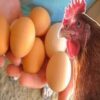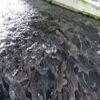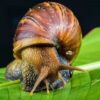In this article, we shall discuss about the uses and importance of fats, vitamins, minerals and water in animal feeds to improve animal production. In contrast to other previous nutrients considered, most of the nutrients here are not used for structural requirements or as raw materials for synthesizing other compounds.
However since the body cannot make them then they must be supplied by our feed.
1. Fats
Fats are made up of carbon, hydrogen and oxygen. Fats are essential components of all cells. The distinction between an oil and a fat is simply that at ordinary room temperature oils are liquid and fats are solid.
A molecule of fat consists of glycerol with three open chain fatty acids (1 Glycerol + 3 fatty acids fat + 3 H2O).
Fats supply essential fatty acids needed for adequate nutrition and normal health. They are mainly included as energy sources as they furnish 9.3 calories per gram compared to 4.1 calories per gram from carbohydrate.
Fats are found in foods of animal and plant origin, we have ―visible‖ fat such as butter, palm oil, groundnut oil and fat in pork, but fat can also be ―invisible‖ like the fat contained in egg yolk, fish, oil seeds
Classification of Fats
The common dietary fat is the triglyceride composed of both saturated, mono-saturated and polyunsaturated fats.
Levels of up to 20% are acceptable in the diets, however, large levels may reduce feed intake and other essential nutrients thereby resulting in reduced growth. Another problem with fat inclusion is the problem of rancidity.
Essential Fatty Acids
Essential fatty acids, or EFAs, are fatty acids that humans and other animals must ingest because the body requires them for good health but cannot synthesize them. There are four (4) essential fatty acids;
- Oleic (an omega-9 fatty acid).
- Alpha-linolenic acid (an omega-3 fatty acid).
- Linoleic acid (an omega-6 fatty acid).
- Arachidonic acid (an omega-6 fatty acid).
Deficiency of these fatty acids leads to defective growth, dry hair, scaly skin and susceptibility to infections.
These essential fatty acids are found in soya bean oil, groundnut oil. palm oil, coconut oil, groundnut oil, melon seeds, fish oil, poultry oil, cotton seed oil and sunflower oil.
Functions of Fats
- Supply energy, a concentrated energy source.
- Fats act as carriers and storage of fat-soluble vitamins.
- Fats are important for maintenance of the skin and coat.
- Steroids, hormones and cholesterol are also fats.
- Insulation of organs.
- Improves palatability.
- Reduce dustiness of feed especially cassava and sweet potato based diets.
- Keeping the body temperature under control.
- Storage or reserve food energy in the body and egg of animal.
- Sparing agent in protein metabolism.
2. Vitamins
In the tropics, the lush vegetation is full of fruits, leafy vegetables, insects and meat animal that provides source of all vitamins.
A varied balanced diet will supply all the necessary vitamins however, in complete absence of a vitamin, clinical conditions known as deficiency diseases develop with fatal consequences.

Animals obtain vitamins through feed they consume, additional supplements of salt lick, microbial synthesis or through maternal transfer
As animal welfare becomes a more important issue with animal protein buyers, the inclusion of necessary vitamin supplements in animal feed should be more important for farmers looking to maximize their animal production.
Vitamins are a group of complex organic compounds which are generally required in the diet in rather small amounts for normal growth and maintenance of health.
In contrast to other nutrients, vitamins are not used for structural or energy requirements or as raw materials for synthesizing other compounds.
Read Also : The Different Species of Pig and their Unique Characteristics
Vitamins are of two types – fat soluble vitamins and water soluble vitamins.
a. Fat soluble vitamins:
| Names | Function(s) | Deficiency Symptom(s) | Source(s) | |
| I. | Vitamin A (Retinol) | Normal vision Epithelium formation | Night blindness Keratinisation Retard growth | Provitamins in green leafy vegetables Milk, fat, liver, carrot |
| II. | Vitamin D (Cholecalciferol) | Absorption of minerals Ca, P and phosphatase levels Bone formation Efficiency of feed utilization, Reproduction | Rickets Irregular teeth | Dry forage, Fish oils |
| III. | Vitamin E (Tocopherol) | Normal reproduction and lactation Antioxidant | Low fertility | Egg yolk, germ oils, oils from oilseeds |
| IV. | Vitamin K (Phylloquinone) | Formation of prothrombin | Failure of blood to clot | Green leafy material, liver Eggs, fish meal |
b. Water soluble vitamins
| Names | Function(s) | Deficiency Symptom(s) | Source(s) | |
| I. | Thiamine (B1) | Carbohydrate metabolism | Beriberi Anorexia, paralysis, convulsions, impaired gastric secretions | Yeast, cereals Plant proteins |
| II. | Riboflavin (B2) | Electron transport system Energy metabolism | Watery eyes ―blood shot Fatty liver Low hatchability | Yeast, green leaves, Milk products, Eggs |
| III. | Niacin | Electron transport chain | ―Black tongue‖ Pellagra Nervous symptoms | Yeast, distillers soluble, rice Wheat bran |
| IV. | Pyridoxine (B6) | Amino acid metabolism | Improper heart function Microcytic anaemia Convulsion | Yeast, cereals Animal tissue |
| V. | Pantothenic acid | Carbohydrate Lipid metabolism | Intestinal disturbances Convulsions | Yeast, liver |
| VI. | Cobalamin (B12) | Amino acid synthesis Protein and nucleic acid synthesis | General weakness | Animal tissue |
| VII. | Folic acid | Transfer of single carbon units Synthesis of choline & N2-bases | Anemia | Groundnuts Liver, leafy vegetables |
| VIII. | Biotin | Fatty acid synthesis Carbohydrate metabolism | General weakness | Yeast, distillers soluble, liver |
| IX. | Choline | Formation of acetylcholine | Fatty livers | Plant protein, wheat Animal tissue |
| X. | Vitamin C | Formation of tissues Wound healing | Bleeding and swollen gums Scurvy | Fruits and vegetables Liver Green peas |
Generally, vitamins are important in regulating body processes and keeping the animal healthy.
3. Minerals
These are inorganic elements useful to the body in many ways. Minerals regulate body processes, can be used for growth and replacement of tissue. Like proteins, the body cannot make minerals hence, minerals must be supplied by our feed
They yield no energy but have important roles to play in many activities in the body.
The total mineral content of plants or animals is called ash.
Classification of Minerals
a. Major Minerals
These are minerals required in large quantities in the diet these include Calcium, Phosphorus, Sodium, Chloride, Potassium and Magnesium.
b. Trace/microminerals
These are minerals required in small amount, examples are Iron, copper, cobalt, manganese, iodine, zinc selenium Sulphur and Fluorine.
The Functions, Deficiency Symptoms and Source of minerals are shown in the table below
| Names | Function(s) | Deficiency Symptom(s) | Source(s) | |
| I. | Calcium | Ossification of bones and teeth Muscle tone Coagulation of blood Selective cell permeability | Rickets Osteomalacia Enlarged parathyroid | Bones Milk Animal products |
| II. | Phosphorus | Ossification of bones and teeth Fat and CHO metabolism Nucleic acid metabolism | Rickets Osteomalacia Retarded growth | Animal products Plant material |
| III. | Sodium | Osmotic regulation Electrolyte and water balance Nerve and muscle action | Muscular cramps General weakness Vascular collapse | Common salt Animal products |
| IV. | Chlorine | Maintains osmotic concentrations Transport of CO2 Solubility of proteins Activates salivary amylases | Alkalosis Hyperexcitability | Animal products Common salts |
| V. | Potassium | Osmotic regulation Enzyme reactions Electrolyte and H2O balance Nerve and muscle action | Slow growth Muscular weakness Herpetrophy of the adrenals | Most ingredients |
| VI. | Magnesium | Ossification of bone and teeth Enzyme activator Decrease tissue irritability, | Nervousness Twitching | Oilseed meals Cereals Bones |
| VII. | Sulphur | Component of some amino acids and vitamin Component of cartilage Synthesis | Reduced thiamine synthesis Retarded growth | Most ingredients |
| VIII. | Iodine | Thyroxine synthesis | Goitre, Stillborn births Cretinisms | Sea food Iodized salts |
| IX. | Iron | Component of Hb and Myglobin Component of cytochrome and Xanthine oxidase | Anaemia Reduced growth Difficult breathing | Meat Green vegetables |
| X. | Copper | Increase iron absorption Formation of erythrocytes | Anaemia De- pigmentation Impaired bone formation | Plant materials |
| Component of enzymes | Impaired reproduction | |||
| XI. | Cobalt | Synthesis of Vitamin B12 Activator of peptidases | Emaciation Macrocytic anaemia | Plant materials |
| XII. | Manganese | Bone formation Functioning of reproductive system | Defective ovulation Testicular degeneration | Grains and roughage |
| XIII. | Zinc | Co-factor of enzymes Bone and feathers RNA synthesis | Lesions on epithelium Atrophy of male reproductive organs | Animal products |
| XIV. | Selenium | Component of enzyme Glutathione peroxidase | Degeneration of pancreas Muscular dystrophy | Plant materials, fish and egg |
| XV. | Fluorine | Prevent dental caries | Enamel density reduction | Drinking water |
4. Water
Water is an important constituent of all forms of life. Its wide distribution within feeds and feedstuffs coupled with its effect on feed quality makes the study of water a significant part of animal nutrition.
Water comprises 65-70% of body weight of an animal at birth and 40-50% of body weight at slaughter. The animal blood is made up of 90-95% water.
Moisture refers to the absolute amount of water present in a feed while water activity has to do with the form in which the water exists in the feed such as free or chemically bound water.
Moisture is the amount of water present in a feed as component, relative to all the other solid constituents such as proteins, carbohydrates, oils and non-water liquids.
Types of Water in Feed
Free water is lightly entrapped and therefore easily pressed from feed matter/feed; the water can be seen and felt. Free water acts as a dispersing agent and solvent and can be removed by drying foods.
Adsorbed water or structural water is a second type of water, which associates in layers via intermolecular hydrogen bonds around hydrophilic food molecules.
Bound water sometimes called the water of hydration is a third form of water in feed or food. It exists in a tight chemically bound situation, such as within a crystalline structure via water-ions or water-dipole interactions. Bound water does not exhibit the typical properties of water such as freezing at C or solvent.
Water Activity
Water activity is a measure of the availability of water molecules to enter into microbial, enzymatic or chemical reactions. This availability determines the shelf- life of feed/food.
The bound water is inversely related to water activity, as the percentage of bound water in a food increases, the water activity decreases. At any given food/feed moisture, water activity will increase with an increase in temperature.
Sources of Water
The main sources of water are potable water;
Metabolic water – is produced by metabolic processes in tissues mainly by the oxidation of nutrients, oxidation of 1g of CHO yields 0.6g of H2O, 1g of fat yields 1.1g of H2O and 1g of protein yields 0.4g of H2O, metabolic H2O is about 5-10% of the total water intake.
Portable water – (stream, borehole, rain, river, bottled water, well, lake).
Tropical feeds and fruits – oranges, watermelon and
Leafy vegetables – water leaf.
Functions of Water
Water is found in all body cells and water is the most abundant of all the nutrients.
Water helps in moistening the alveoli in the lungs for respiration and gaseous exchange.
Water has high specific heat and by this property it disperses heat fast.
It regulates body temperature through sweat and consequently cools the body.
Water intake helps to prevent constipation in animals.
Water is responsible for movement of minerals across cells and removal of metabolic wastes from the body.
It is essential for mixing of drugs for man and farm animals.
Water supports chemical reactions like digestion, absorption, excretion and maintains shape of cells.
Water lubricates and cushions joints and organs in the body e.g. synovial fluid, cerebrospinal fluid.
Effects of Water on Feed/Feed Ingredients
The nutritive value and dry matter content of the feed is affected by the amount of water present in the feed.
High water content (above 15%) lowers nutritive value at storage and moulds may grow.
Water make silage making easy where 90% water content is fairly tolerated, at times water may be added to mature forage crops to ease packing which is done to exclude air.
Water affects silage preservation; excess water content of silage may cause loss of mineral through seepage into the surround soil of silage pit.
Water prevents dustiness of prepared feed/feedstuff but animals get little nutritive value when fed feeds of high water content.
Water dilutes concentration of energy in feeds hence feeds should be supplied to animals on dry matter basis.
Water as an ingredient. Water is given to farm animals and can be incorporated as component of processed food.
In summary, it is important to note the various feed nutrients considered in this article as the lack of any will affect the health of the animal and thereby affect product quality.
Feed nutrients such as fats, minerals, vitamins and water are essential because the animal cannot synthesize them. Their various functions and their sources have been studied so as to know the basis of using different feeds.
Read Also : San Francisco Textile Recycling Center





